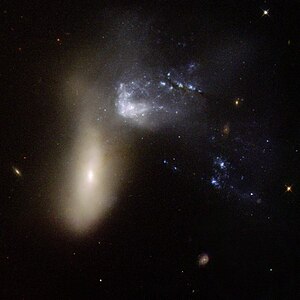NGC 454
| Galaxie NGC 454 | |
|---|---|
 | |
| Aufnahme des Hubble-Weltraumteleskops; links die elliptische, östliche Komponente (NGC 454E), rechts die irreguläre, westliche Komponente (NGC 454W) | |
| AladinLite | |
| Sternbild | Phönix |
| Position Äquinoktium: J2000.0, Epoche: J2000.0 | |
| Rektaszension | 01h 14m 22,5s[1] |
| Deklination | −55° 23′ 55″[1] |
| Erscheinungsbild | |
| Morphologischer Typ | W: Irr E: S0 pec? / Sy2[2] |
| Helligkeit (visuell) | W: 12,2 mag E: 13,7 mag[2] |
| Helligkeit (B-Band) | W: 13,1 mag E: 14,5 mag[2] |
| Winkelausdehnung | W: 1.7/1.5 E: 1.0/0.5[2] |
| Positionswinkel | W: 15° E: 90°[2] |
| Flächenhelligkeit | W: 13,1 mag/arcmin² E: 12,8 mag/arcmin²[2] |
| Physikalische Daten | |
| Rotverschiebung | 0.01215 ± 0.000147[1] |
| Radialgeschwindigkeit | (3645 ± 44) km/s[1] |
| Hubbledistanz H0 = 73 km/(s • Mpc) | (158 ± 11) · 106 Lj (48,5 ± 3,4) Mpc [1] |
| Durchmesser | 85.000 + 50.000 Lj[3] |
| Geschichte | |
| Entdeckung | John Herschel |
| Entdeckungsdatum | 5. Oktober 1834 |
| Katalogbezeichnungen | |
| NGC 454 • PGC 4461/4468 • ESO 151-IG036 • IRAS F01123-5539 • AM 0112-554 • GC 253 • h 2397 • | |
NGC 454 ist ein wechselwirkendes Galaxienpaar im Sternbild Phönix, welches etwa 158 Millionen Lichtjahre von der Milchstraße entfernt ist. Das Paar besteht aus einer linsenförmigen Galaxie (östliche Komponente, NGC 454E) und einer irregulären Galaxie (westliche Komponente, NGC 454W).
Das Objekt wurde am 5. Oktober 1834 von John Herschel entdeckt.[4]
Literatur
- M. Stiavelli et al.: WFPC2 Observations of NGC 454: An Interacting Pair of Galaxies. In: The Astrophysical Journal Letters, Band 492, Nr. 2, 10. Januar 1998, S. L135–L138, doi:10.1086/311115
Weblinks
Einzelnachweise
Auf dieser Seite verwendete Medien
NGC 454 is galaxy pair comprising a large red elliptical galaxy and an irregular gas-rich blue galaxy. The system is in the early stages of an interaction that has severely distorted both components. The three bright blue knots of very young stars to the left of the two main components are probably part of the irregular blue galaxy. Although the dust lanes that stretch all the way to the center of the elliptical galaxy suggest that gas has penetrated that far, no signs of star formation or nuclear activity are visible. The pair is approximately 164 million light-years away.
This image is part of a large collection of 59 images of merging galaxies taken by the Hubble Space Telescope and released on the occasion of its 18th anniversary on 24th April 2008.
| About the object | |
|---|---|
| Object name | NGC 454 |
| Object description | Interacting Galaxies |
| Position (J2000) | 01 14 26.10 -55 23 40.00 |
| Constellation | Phoenix |
| Distance | 150 million light-years (50 million parsecs) |
| About the data | |
| Data description | The Hubble image was created using HST data from proposal 7129: M. Stiavelli (STScI) |
| Instrument | WFPC2 |
| Exposure date(s) | March 6, 1997 |
| Exposure time | 31 minutes |
| Filters | F450W (B), F606W (V), and F814W (I) |
